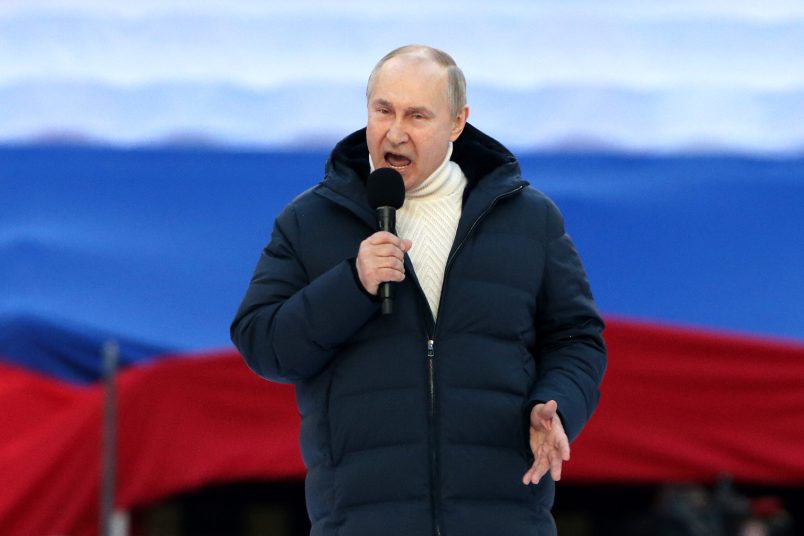Vladimir Putin may yet expand his war against Ukraine, and it’s via a country you probably haven’t heard of.
It’s Transnistria, little-known in part because it barely exists.
One of the original “frozen conflicts” that emerged after the fall of communism, the statelet is an unrecognized Russian proxy republic contained entirely within Moldova. It covers a thin strip of land that borders Ukraine’s west, removed from where the bulk of fighting has taken place.
But it may be the next flashpoint in Russia’s war against Ukraine, opening up a new front in the war or, at the very minimum, ratcheting up pressure on the Ukrainian military. Below are five points on the statelet and why it matters:
What is Transnistria?
Known regionally for its cognac factory and Soviet-era arms dump, Transnistria covers a 250-mile strip of land along the Dniester river that makes up most of Moldova’s eastern border with Ukraine.
Its capitol is Tiraspol, a small city on the road between Ukraine’s Black Sea port of Odessa and Moldova’s capital of Chisinau. Travelers going between the two cities need to submit to three border control procedures: Ukrainian, Moldovan, and, crucially, Transnistrian.
It calls itself the Pridnestrovian Moldovan Republic, maintains its own border controls, and remains in an undeclared — but “frozen” — state of war with Moldova.
It’s one of the first ‘frozen conflicts’ in the former USSR.
Transnistria is one of the grandaddies of so-called “frozen conflicts” in the former Soviet Union. The Ukrainian regions of Donetsk and Luhansk were other examples — though they were “unfrozen” on Feb. 22, 2022.
These are regions where there’s low-level military activity by Russian proxies, aimed at defending the existence of a state that few outside of the Kremlin acknowledge as real.
Transnistria’s war began as the Soviet Union was dissolving, in November 1990. The story is familiar: separatists in the Russian-speaking region appealed to Moscow for help, claiming supposedly impending oppression by the Moldovan-speaking majority.
The result, after nearly two years of battle, was the creation of Transnistria — de facto independent and home to Russian military bases, but de jure part of Moldova.
The conflict never formally ended, and was instead “frozen,” creating a massive headache for Moldova’s development. Transnistria itself has been dominated by the kind of mafia rule that’s come to characterize the other “frozen,” unrecognized statelets that Russia has created.
Now, it might get ‘unfrozen.’
Since Russia launched its full-fledged war against Ukraine in February, military analysts have pointed to Transnistria as a potential option for the Kremlin to expand its war.
In the war’s early days, Belarusian President Aleksandar Lukashenka appeared in front of a map of military plans that appeared to show an offensive from the statelet, but speculation kicked into high gear last week after a Russian military official said that Moscow’s war aims included building a land corridor across Ukraine’s south, ending at the statelet.
Since then, a number of ominous events have taken place. Explosions sounded throughout the region on Monday, with local officials blaming them on Ukrainian saboteurs. The statelet’s government said that it would soon decide whether to “protect the interests of the republic,” as images circulated online of military checkpoints appearing within the breakaway region.
Why now?
Russia has faced real setbacks in its war against Ukraine.
But Russian officials — and news reports — have suggested in recent days that Putin’s focus has shifted towards a land grab in southern Ukraine, the region where the Kremlin’s military campaign has had the most success.
The threat also comes as NATO has cast off whatever apprehensions it may have had about supplying heavy weapons to Ukraine’s military. Transnistria entering the conflict in some respect would expand the war laterally, bringing in another country — Moldova.
Like Ukraine, Moldova is not part of NATO.
The risks may be very, very large.
It’s not clear what Transnistrian involvement in the conflict would look like.
Moldovan President Maia Sandu blamed the “escalation” on Russian proxies in Transnistria itself.
But for a war that’s so far been contained within Ukraine, expanding it to Moldova would open up a new southern front for NATO to worry about — adding Romania to a list of countries near the fighting with reason to worry about strikes or accidental escalation, a list that already includes Poland, the Baltics, and Slovakia.







And just like Russia was always going to turn to Moldova or some new victim after destroying and taking Ukraine, the GQP Trump KKKult doesn’t intend to stop once it has destroyed and taken all chance of Dem/liberal control. Anyone who thinks the disease isn’t progressive is a fool. The GQP will emulate Putin/Russia in every way and Putin/Russia are just emulating Hitler and the Nazis. Genocide is coming to this continent. Bank on it.
YOU ARE CORRECT …
Gen. Milley’s comments about time not being on Ukraine’s side must have been intended to justify an increase in US military support for Ukraine. Between sanctions and the mounting Russian death toll, I can’t see time being on Russia’s side, either. And Putin wants to expand it to Moldova?
I can’t help thinking that his quest for “Greater Russia” is going to end up turning it into a vassal state of China.
Putin wishes he had that much hair…